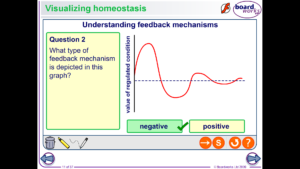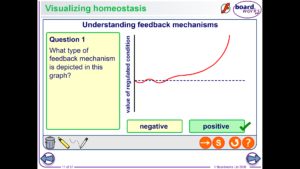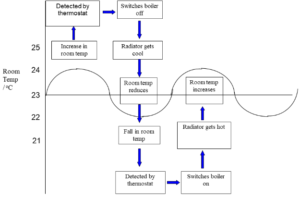Organisms respond to changes in their internal and external environments (AQA A2 Biology) PART 7 of 9 TOPICS
|
Principals of homeostasis and negative feedback:
Homeostasis in mammals involves physiological control systems that maintain the internal environment within restricted limits.
Not maintaining a stable core body temperature and pH may cause an enzyme to slow its activity down or to denature.
Stable glucose concentration allows cells to respire and keeps the water potential constant. This prevents shrivelling and bursting of cells.
Positive feedback is when levels rise of a certain factor but does not fall in the end and keeps rising to the normal. An example is during the first part menstrual cycle. Before ovulation, small amounts of oestrogen are secreted from the ovary. This stimulates GnRH from the hypothalamus in the brain and LH from the pituitary gland, also in the brain. GnRH also stimulates the release of LH. LH causes oestrogen to be secreted where the level of oestrogen rise. This has a knock-on effect by raising the levels of GnRH and LH. The level keep rising which is called positive feedback. NB: This example, as well as the one for negative feedback and multiple negative feedback, does not need to be known off by heart but is an example for you to understand what is meant by positive feedback. Other examples may be given in the exam.
Negative feedback is when levels fall and keep falling to the normal. An example is the second part to the menstrual cycle. After ovulation, the corpus luteum is formed in the ovary and begins to secrete progesterone in response to high levels of LH. This inhibits the release of GnRH from the hypothalamus in the brain and LH from the pituitary gland in the brain. The levels of both GnRH and LH decrease further known as negative feedback.
Multiple negative feedback is where negative feedback used to bring levels back to the normal. NB: Remember that positive feedback is not part of multiple negative feedback even though levels rise in some parts. The levels rise and stop at the normal and do not keep on rising like positive feedback. A combination of the two allows more control than just using one because the levels can be more stable around the normal and is less likely to get the levels too high or too low of a certain factor. An example of this is the menstrual cycle put together. A combination of the two allows levels of LH to fluctuate from high to low depending on the stage of the menstrual cycle.






